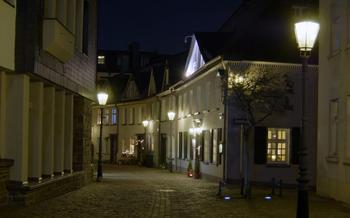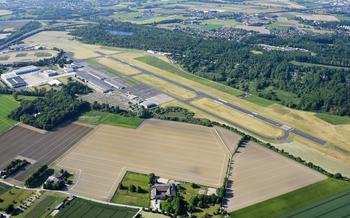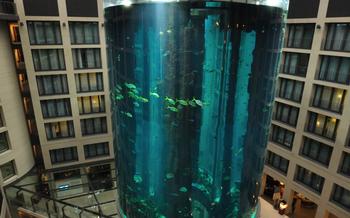
Wildgehege Mesekendahl
- Wildgehege Mesekendahl: A Natural Haven for Wildlife Enthusiasts
- Exploring the Diverse Animal Kingdom
- Witnessing the Majestic Red Deer
- Walking Among the Friendly Alpacas
- Observing the Playful Wild Boar
- Encountering the Agile Squirrels
- Spotting the Colorful Pheasants
- Learning About the Park's Conservation Efforts
- Taking a Break at the Picnic Area
- Exploring the Children's Playground
- Attending Educational Events and Workshops
- Capturing the Perfect Wildlife Photographs
- Insider Tip: Unveiling a Hidden Gem
Wildgehege Mesekendahl: A Natural Haven for Wildlife Enthusiasts
Nestled in the picturesque Sauerland region of Germany, Wildgehege Mesekendahl is a wildlife park that offers a captivating glimpse into the diverse wonders of nature. Established in 1994, the park is dedicated to preserving and showcasing the beauty of the local flora and fauna. With over 30 hectares of pristine forest, rolling hills, and tranquil ponds, Wildgehege Mesekendahl provides a sanctuary for a wide range of animal species, including majestic red deer, playful alpacas, agile squirrels, and colorful pheasants.
As you step into the park, the air is filled with the sounds of birdsong and the rustling of leaves underfoot. The lush greenery and tranquil atmosphere create a sense of peace and serenity, inviting you to immerse yourself in the wonders of the natural world. Guided tours are available for those who wish to learn more about the park's inhabitants and their unique characteristics. Whether you're a seasoned wildlife enthusiast or simply looking for a fun and educational day out, Wildgehege Mesekendahl promises an unforgettable experience for visitors of all ages.
Exploring the Diverse Animal Kingdom
Wildgehege Mesekendahl alberga a diverse array of animal species, each possessing unique characteristics, behaviors, and adaptations. Among the mammals, red deer, alpacas, and wild boar are undoubtedly the most captivating. Visitors can observe the majestic red deer grazing gracefully in the meadows, their impressive antlers commanding attention. Alpacas, with their gentle nature and inquisitive personalities, offer a heartwarming encounter. Their soft fleece and curious eyes make them a delight to watch. Wild boar, with their distinctive appearance and foraging habits, add a touch of intrigue to the park's ecosystem. Their social interactions and role in maintaining ecological balance are fascinating to witness.
In addition to mammals, the park is home to a variety of bird species. Pheasants, with their vibrant plumage and distinctive calls, are a visual and auditory delight. Their courtship rituals and diverse habitats make them a favorite among bird enthusiasts. Squirrels, with their agility and entertaining antics, bring a touch of playfulness to the forest. Their nesting habits, communication methods, and role in seed dispersal highlight their importance in maintaining forest health.
The park's reptile collection includes various species of snakes and lizards. Visitors can learn about their unique adaptations, such as shedding their skin and using their tongues to detect prey. The park's educational programs and guided tours provide valuable insights into the behavior, biology, and conservation status of these fascinating creatures.
Preserving biodiversity and respecting wildlife habitats are of paramount importance at Wildgehege Mesekendahl. The park actively engages in conservation efforts, promotes responsible tourism, and educates visitors about the significance of protecting our natural heritage. By fostering a deeper understanding and appreciation for wildlife, the park contributes to the conservation of these incredible species and their habitats.
Witnessing the Majestic Red Deer
Among the diverse inhabitants of Wildgehege Mesekendahl, the red deer stands out as a symbol of grace and elegance. These magnificent creatures hold a prominent place in the park's ecosystem, contributing to its ecological balance and captivating visitors with their regal presence.
Observing red deer in their natural habitat is a truly awe-inspiring experience. As you wander through the park, keep an eye out for these majestic animals grazing peacefully in the meadows or seeking shelter in the shade of the trees. Their graceful movements and striking appearance are sure to leave a lasting impression.
One of the most captivating aspects of red deer is their social dynamics. These animals live in herds, and their interactions with each other are fascinating to watch. Observe as they establish dominance hierarchies, form bonds, and care for their young. Witnessing the interplay between individual deer provides a glimpse into the complex social structures that exist in the wild.
Male red deer, known as stags, are particularly impressive during the rutting season. During this time, they engage in fierce battles for dominance, using their impressive antlers as weapons. The clashing of antlers and the bellowing calls of the stags create a thrilling spectacle that showcases the raw power and determination of these majestic creatures.
Whether you spot a solitary stag standing guard, a doe tending to her fawn, or a herd grazing peacefully in the distance, encountering red deer at Wildgehege Mesekendahl is an experience that will stay with you long after your visit. So, grab your binoculars, embrace the tranquility of the forest, and prepare to be captivated by the beauty and majesty of these remarkable animals.
Walking Among the Friendly Alpacas
Charming and gentle, alpacas are one of the most beloved residents of Wildgehege Mesekendahl. These South American camelids, with their soft wool and expressive eyes, are a delight to encounter. Their curious nature often leads them to approach visitors, creating heartwarming moments of interaction.
Originally hailing from the Andes Mountains, alpacas have adapted well to the park's environment. Their thick fur protects them from the cold, while their padded feet allow them to navigate the hilly terrain with ease. Their diet consists primarily of grasses and hay, which they graze on throughout the day.
While alpacas are known for their wool, which is highly valued for its softness and warmth, they also play a cultural role in South America. In their native lands, alpacas have been revered for centuries, and their wool has been used to create intricate textiles and garments.
At Wildgehege Mesekendahl, visitors have the opportunity to get up close and personal with these gentle creatures. A highlight for many is the chance to hand-feed the alpacas. As you offer them a treat, you'll be rewarded with their curious gazes and gentle nibbles.
The park also offers guided tours that provide insights into the history, behavior, and significance of alpacas. These tours are an excellent way to learn more about these fascinating animals and their role in the park's ecosystem.
Whether you're a wildlife enthusiast, a nature lover, or simply seeking a peaceful encounter with gentle creatures, the alpacas at Wildgehege Mesekendahl are sure to leave a lasting impression.
Observing the Playful Wild Boar
Wild boar, with their stocky build, coarse fur, and distinctive snout, are a fascinating sight to behold. These social creatures roam the park in small groups, foraging for food and interacting with each other in a complex social structure. Visitors can witness their playful nature as they chase each other through the undergrowth, wallow in mud baths, or engage in playful fights.
Wild boar are omnivorous and play a crucial role in maintaining the ecological balance of the park. They feed on a variety of plant matter, including roots, tubers, fruits, and nuts, as well as insects, worms, and small animals. Their rooting behavior helps to aerate the soil and disperse seeds, contributing to the overall health of the forest ecosystem.
It is important to observe wild boar from a respectful distance and avoid disturbing their natural behavior. Visitors should never approach or feed the animals, as this can cause stress and disrupt their natural routines. By respecting their habitat and observing them from afar, visitors can gain a deeper appreciation for the unique characteristics and ecological importance of these fascinating creatures.
Encountering the Agile Squirrels
As you stroll through the forest, the chattering sounds of squirrels echo through the trees. These agile and entertaining creatures are a delight to encounter, their playful antics and acrobatic leaps providing endless amusement. Observe them as they scurry up tree trunks, their sharp claws gripping the bark effortlessly, and then gracefully glide down, their bushy tails serving as parachutes.
With their curious nature, squirrels are often seen foraging for food, their tiny paws delicately picking up nuts and seeds. They have a diverse diet, including acorns, hazelnuts, and beechnuts, which they store in hidden caches for later consumption. Their hoarding behavior contributes to forest regeneration, as they inadvertently plant new trees by burying nuts that they forget to retrieve.
Wildgehege Mesekendahl is home to several species of squirrels, including the red squirrel, the European pine marten, and the Eurasian red squirrel. Each species has its own unique characteristics, but they all share a love for climbing and jumping. Red squirrels, with their striking reddish-brown fur and tufted ears, are particularly acrobatic, often performing impressive leaps between branches.
Squirrels play a crucial role in the forest ecosystem, contributing to seed dispersal and maintaining forest health. By burying nuts and seeds, they help to regenerate the forest and provide food for other animals, such as birds and insects. Their playful and curious nature also makes them a joy to watch, reminding us of the wonders of the natural world.
Spotting the Colorful Pheasants
As you stroll through the park, keep an eye out for the vibrant flashes of color that betray the presence of pheasants. These magnificent birds, with their iridescent plumage and distinctive calls, are a delight to both the eyes and ears.
Pheasants are found in a variety of habitats within the park, from dense thickets to open grasslands. They are most active during the early morning and evening hours, when they can be seen foraging for food or engaging in their elaborate courtship rituals.
One of the most striking features of pheasants is their plumage. The males, in particular, are adorned with a kaleidoscope of colors, including fiery reds, shimmering greens, and deep blues. Their long, flowing tails add to their majestic appearance.
In addition to their visual appeal, pheasants are also known for their distinctive calls. The males have a loud, crowing call that can be heard from a distance, while the females have a softer, clucking sound.
Pheasants play an important role in the park's ecosystem. They help to control insect populations and disperse seeds, contributing to the overall health and biodiversity of the forest.
Capturing the perfect photograph of a pheasant can be a challenge, as they are often shy and elusive. However, with patience and observation, you may be rewarded with a stunning shot of these beautiful birds.
Learning About the Park's Conservation Efforts
Wildgehege Mesekendahl is dedicated to preserving wildlife and their natural habitats. The park actively engages in conservation efforts to protect the diverse species that call it home. Through educational programs and research initiatives, the park aims to raise awareness about the importance of biodiversity and inspire visitors to become advocates for conservation.
The park's educational programs are designed to inform and engage visitors of all ages about wildlife conservation. Guided tours led by experienced naturalists provide fascinating insights into the park's ecosystems, animal behavior, and the challenges facing wildlife today. Interactive exhibits and workshops allow visitors to learn about conservation topics in a hands-on way.
In addition to education, the park conducts scientific research to contribute to the understanding and protection of wildlife. Researchers study the behavior, ecology, and genetics of the park's animal populations, contributing to the body of knowledge that informs conservation strategies. The park also collaborates with other conservation organizations and institutions to share research findings and promote best practices.
Visitors to Wildgehege Mesekendahl have the opportunity to contribute to conservation efforts through volunteering or donations. Volunteer opportunities include assisting with animal care, habitat restoration projects, and educational programs. Donations help fund the park's conservation initiatives, ensuring the continuation of its vital work.
By supporting the conservation efforts at Wildgehege Mesekendahl, visitors can play a role in protecting wildlife and their habitats for future generations. Every contribution, whether through education, research, or financial support, helps to make a difference for the animals that call the park home.
Taking a Break at the Picnic Area
Wildgehege Mesekendahl provides visitors with designated picnic areas, offering a chance to rest, refuel, and soak in the serene atmosphere. These areas are strategically located throughout the park, allowing you to enjoy a leisurely lunch break while surrounded by the sounds of nature.
Pack a delicious picnic lunch filled with your favorite snacks and beverages. Choose from a variety of options, such as sandwiches, fresh fruits, homemade cookies, or a thermos of hot soup for a chilly day. Remember to bring a blanket or a tablecloth to spread out on the ground and create a cozy seating area.
As you savor your meal, take a moment to appreciate the tranquility of the surroundings. Listen to the gentle rustling of leaves, the chirping of birds, and the distant calls of animals. Let the beauty of nature rejuvenate your senses and create lasting memories with your loved ones.
Before leaving the picnic area, ensure you dispose of your waste responsibly. There are designated bins placed throughout the park for this purpose. By following these simple guidelines, you can help maintain the cleanliness and beauty of Wildgehege Mesekendahl for future visitors to enjoy.
Exploring the Children's Playground
Wildgehege Mesekendahl understands the importance of engaging young minds with nature and offers a well-equipped playground within the park's premises. Designed to provide entertainment and educational opportunities for younger visitors, the playground seamlessly blends fun and learning.
The playground features a variety of structures that cater to children of different ages and abilities. Swings, slides, and climbing frames encourage physical activity and coordination, while interactive elements like puzzles and sensory games stimulate cognitive development. The playground's natural surroundings add an extra layer of excitement, allowing children to explore and connect with nature as they play.
Parents and guardians can rest assured of their children's safety, as the playground is designed with soft, impact-absorbing surfaces and regular maintenance ensures that all equipment is in top condition. The presence of benches and seating areas allows adults to relax and supervise while their children enjoy their time at the playground.
Encouraging children to spend time outdoors and engage with nature through play is vital for their physical, mental, and emotional well-being. Wildgehege Mesekendahl's playground provides an ideal setting for kids to learn about the natural world, develop a love for the outdoors, and create lasting memories of their visit.
Attending Educational Events and Workshops
Wildgehege Mesekendahl offers a variety of educational events, workshops, and guided tours that provide visitors with an opportunity to learn more about wildlife, conservation, and the park's ongoing projects. These events are led by experienced naturalists and educators who share their knowledge and passion for the natural world.
Educational events can range from lectures and presentations to interactive workshops and hands-on activities. Visitors can learn about the ecology of the park, the behavior and biology of the animals, and the importance of conservation. Workshops might focus on topics such as wildlife photography, birdwatching, or plant identification.
Guided tours offer a unique opportunity to explore the park with an expert guide who can provide insights into the wildlife and the park's conservation efforts. Visitors can ask questions, learn about the history of the park, and get a behind-the-scenes look at the work that goes on to care for the animals and maintain their habitat.
Attending educational events and workshops at Wildgehege Mesekendahl is a great way to deepen your understanding of the natural world and to gain a new appreciation for the importance of conservation. These events are suitable for visitors of all ages and are a great way to learn and have fun at the same time.
Insider Tip: Check the park's website or social media pages for upcoming events and workshops. Some events require advance registration, so it's a good idea to plan ahead.
Capturing the Perfect Wildlife Photographs
Wildgehege Mesekendahl presents an exceptional opportunity for wildlife photography enthusiasts to capture stunning images of animals in their natural habitat. To achieve the perfect shot, consider these tips:
-
Camera Settings: Opt for a camera with manual settings to control the shutter speed, aperture, and ISO. A fast shutter speed (1/1000th of a second or faster) is crucial to freeze motion, while a wide aperture (f/4 or larger) allows more light to enter, creating a shallow depth of field that blurs the background and highlights the subject.
-
Lens Selection: Choose a telephoto lens with a focal length of at least 200mm to bring distant subjects closer. A zoom lens offers versatility, allowing you to adjust the focal length as needed.
-
Composition Techniques: Experiment with different angles and perspectives to create dynamic compositions. Get low to capture eye-level shots that establish a connection with the animals. Use leading lines, such as trails or branches, to draw the viewer's attention to the subject.
-
Patience and Observation: Wildlife photography requires patience and the ability to observe animals without disturbing them. Take your time, study their behavior, and wait for the perfect moment to capture the desired shot.
-
Respecting Wildlife: Always prioritize the well-being of the animals. Avoid making loud noises or sudden movements that may startle them. Maintain a safe distance and use a long lens to capture images without encroaching on their personal space.
Sharing your wildlife photography with others can inspire a love for nature and raise awareness about the importance of conservation. Join online photography communities, participate in photo contests, or create a blog or social media account to showcase your work and connect with fellow enthusiasts.
Insider Tip: Unveiling a Hidden Gem
As you venture deeper into the park, you'll discover a hidden gem that offers a unique perspective and encounter. Nestled amidst the lush forest, there's a secluded pond that serves as a haven for a variety of waterfowl. Here, you can witness the graceful ballet of swans, the playful antics of ducks, and the vibrant colors of kingfishers. The tranquility of the pond creates a serene atmosphere, allowing you to observe these beautiful creatures in their natural habitat. Remember to bring your binoculars or a camera with a telephoto lens to capture the stunning moments of these elusive birds.
I stumbled upon this hidden gem during one of my early morning walks in the park. As the mist lifted, revealing the tranquil surface of the pond, I was captivated by the symphony of bird calls that filled the air. I spent hours observing the intricate behaviors of these waterfowl, marveling at their beauty and grace. Since then, this secluded spot has become my favorite retreat within the park.
So, dear travelers, as you explore Wildgehege Mesekendahl, don't hesitate to venture off the beaten path and seek out its hidden treasures. Embrace the spirit of discovery and be rewarded with unforgettable encounters with nature's wonders.









